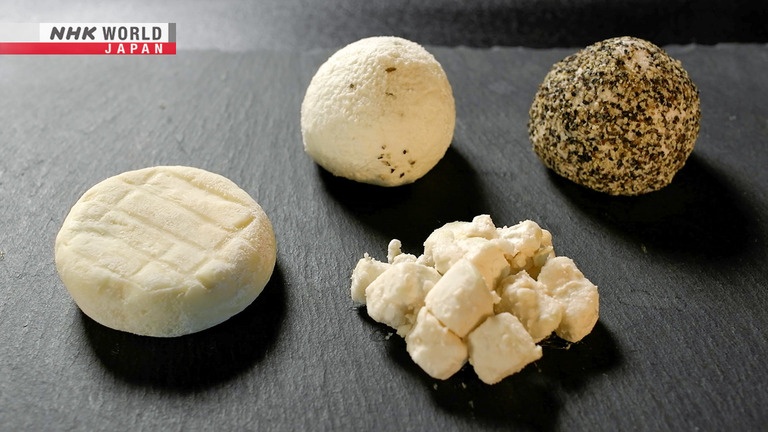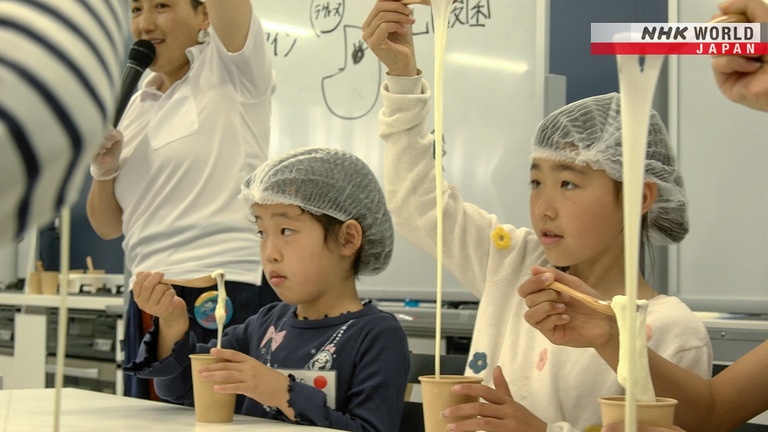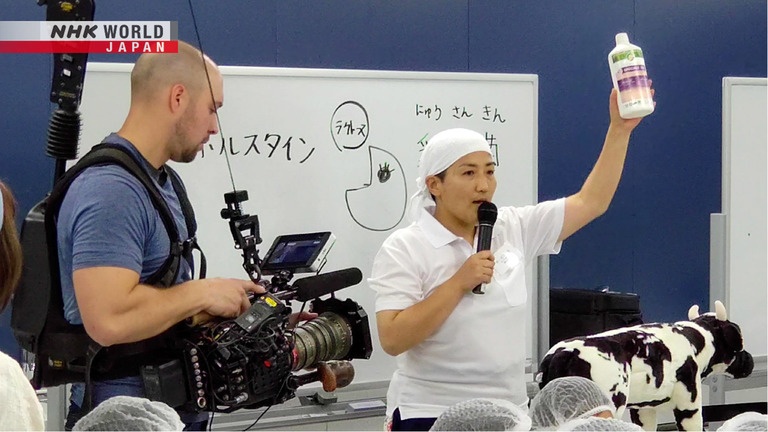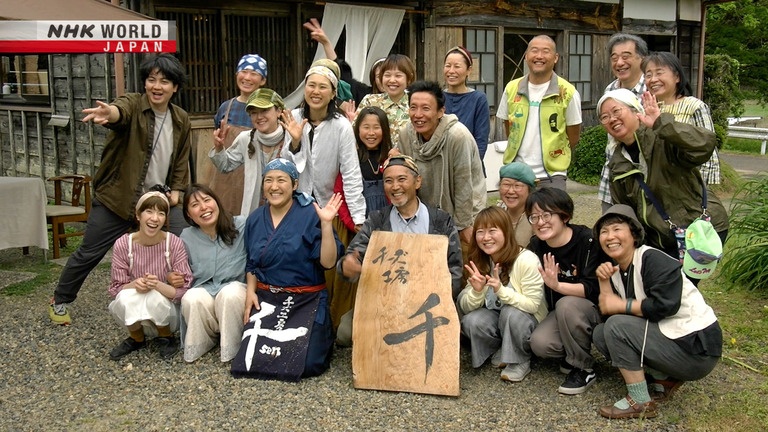Japanese Cheese Trailblazer - Shibata Chiyo
In rural Chiba Prefecture, Shibata Chiyo runs a pioneering cheeseworks out of a 120-year-old farmhouse. Her focus is 100% local fermented cheeses, and just three years after launching in 2014, she became the first female cheesemaker to win a prestigious award from Japan's Ministry of Agriculture, before going on to place third out of 3,804 entries in the 2019 World Cheese Awards. This time on FRONTRUNNERS, we follow a cheesemaker with a uniquely Japanese approach to fromage and sustainability.




Transcript
FRONTRUNNERS
Through cheese, I want to convey the beauty of Japan to the world.
It's so good!
It's milky, not too strong. It really matches my tastes.
To me, her cheese is very unique.
I haven't had it in other places.
Cheese made me who I am today!
Japanese cheese trailblazer
Shibata Chiyo
Otaki, Chiba Prefecture has been known since samurai times for its castle.
And these days, it has another landmark.
This cheeseworks run from a 120-year-old farmhouse.
Open only once a month,
it attracts crowds of visitors from Tokyo and even further afield.
It's run entirely by founder and cheesemaker, Shibata Chiyo.
And the customers come for her unique artisanal cheeses.
Fermented with carefully-sourced domestic heirloom microbes
like yeasts and lactic acid bacteria.
Her best-known cheese, named "Ubusuna,"
uses 13 separate kinds of microbe.
In 2019, it claimed third prize in an international contest.
This cheese is nice and chewy.
And the milky taste and cheesy aroma just unfurl in your mouth.
It's lovely.
It tastes totally different to the cheese you get at the supermarket.
It's like tasting something totally new.
There's a distinct flavor that Chiyo-san has around the preparation
that I just have not tasted elsewhere.
It has that kind of flavor that I think is probably very grounded here,
on this land, in this location.
Let's take a quick picture. Everybody over here.
It's 7 a.m.
Shibata heads out to a local dairy farm to collect her milk.
It's a very progressive farm.
An early adopter in all sorts of areas
with lots of great initiatives.
The unique taste of this local milk underpins Shibata's cheeses.
Good morning!
Takahashi Kenji has been running this dairy for 35 years.
His focus is on circular agriculture
tied in to the local environment and resources.
I try to use 100% domestic feed. That's my aim.
And my decision to take on the challenge of growing my own soy beans
was part of that approach.
Kenji's wife Naomi works closely with local suppliers
to secure ingredients for their feed.
This is sake lees.
And this is made from wheat.
There's bamboo charcoal in there, hence the color.
It's rich in amino acids.
We don't like to see things go to waste,
and when we did the math, these ingredients were rich in nutrition.
And as they're fermented,
they're a good match for the cows' digestive systems.
And this feed mix also has a positive influence
on the flavor of cows' milk.
It's creamy, but very clean tasting.
Milk really concentrates features of the local environment,
and that's reflected directly in the flavor.
Straight after collection,
Shibata pasteurizes the milk to eliminate bacteria.
But, while this is a requirement under Japanese law...
You lose both bad and good bacteria.
Bacteria can help bring that local flavor, that depth.
Without them, you lose that character.
That's why Shibata uses fermentation to reintroduce the microbes
that bring out the flavor of her cheeses.
Her cheeseworks features special equipment
for culturing such microorganisms.
And everything is fine-tuned down to the nearest centigram.
It's a constant dialogue with the microbes,
measuring them out and fermenting them.
Creating new life.
It was Shibata's father, Zenshiro,
who first introduced her to the wonder of cheese.
His work with a French airline
gave the family access to some of the world's finest cheeses.
We always had these delicious French cheeses in the house.
Too lavish really to just guzzle them down,
but that was normal for us.
I guess I'm the type of person
who will really apply myself to the things I love,
so I went to learn about cheese at college.
With her sights set on becoming a cheesemaker,
she enrolled at Tokyo University of Agriculture
to learn about fermentation and microbial action...
before going on to serve an apprenticeship
with a cheesemaker in Hokkaido.
It was there that she met French cheese expert, Jean Hueber.
And he would provide some advice that would change the course of her life.
He said the time for copying European cheeses was over,
that I should create something original.
He convinced me this was an age
in which you could express your own uniqueness.
And that was the moment I really got serious about this as a calling.
She began with a spell in France, to learn even deeper secrets,
returning to Japan intent on creating something unique.
However...
My dad suffered a stroke.
And around the same time, I started treatment for Graves' Disease,
a condition of the thyroid,
so I wasn't able to pursue my goals as I'd hoped.
To cover the costs of my treatment,
I had to take a job in a hotel, with hospital visits every week.
After years of battling ill health,
finally in 2014, she was able to open her own cheeseworks.
But initial sales were slow.
I couldn't sell what I made.
Over and over, without making a single yen of profit,
I ended up just tossing my cheese on the compost
and taking a hit on the ingredients, packaging, lighting and heating.
That went on for two years. It was tough.
To refine her produce, she conducted research at a laboratory in Tokyo.
And there, she made a key discovery.
The brine used in fish drying
contains microbes that are ideal for cheesemaking.
I was amazed to find indigenous Japanese lactic acid bacteria
suitable for cheesemaking,
and began to search for more and more.
Without that discovery,
I might never have found the impetus to work with indigenous microbes.
Those long-ignored bacteria
provided a new starting point for Shibata's cheesemaking.
We're all living things.
So when you talk to them, that positive energy resonates.
I really enjoy this.
Every day, I come in and I wish them all "Good morning."
Since those early days,
she's continued to find unique Japanese microbes
in the most unexpected places.
Can you find microbes in rice, too?
Yes, you can!
In 2019, she finally took a cheese
made with indigenous microbes to the global stage.
That cheese was... Ubusuna.
Another important step, is a dusting of charcoal.
The alkalinity of the charcoal balances out the acidity of the cheese
to act as a natural preservative.
I borrowed the name "Ubusuna" from a Shinto deity, "Ubusuna-gami."
It symbolizes new life and new beginnings.
It's also linked to a Japanese word
meaning the first cries of a newborn baby,
so that seemed ideal for this cheese
made with Japanese microbes to announce itself to the world.
It also raised the curtain on our aspirations as a cheeseworks.
The charcoal, too, comes from local wild rice,
a crop that has long been used in Japan
both as a foodstuff and for its medicinal properties.
It's even used for ceremonial ropes as at Izumo Grand Shrine,
as well as in purification rituals.
Ubusuna combines this Japanese tradition with a sweet, fruity aroma.
And at the 2019 World Cheese Awards,
it placed third out of some 3,800 entries.
It was confirmation that a global audience
was finally ready to accept Shibata's cheeses.
I was so happy to hear praise
for Ubusuna's aroma as "unlike any prior cheese."
So happy that I wept behind the refrigerator in my display booth.
But while she'd finally managed to fulfill her pledge to her mentor Jean Hueber
with a truly unique Japanese cheese,
sadly he wasn't alive to see it.
I was gutted not to have made it in time.
I wanted to share Ubusuna with him,
but by the time it was ready, he'd already passed on.
But sometimes, I do put my hands together and say to him, "We did it."
Shibata lives alone in the cottage next to her cheeseworks.
And through the years of hard work,
a key part of her self-care routine has been a dose of morning yoga.
Hey! Good morning!
He is a local farmer.
These are for you. They're a bit gnarly...
For me?
Not so easy to work with.
They'll do great!
Throughout her nine years here,
these local relationships have been precious to Shibata.
I always see how hard she works and how well she's doing.
I'll have to work just as hard on my vegetables, too.
Lovely whey today.
Whey is the liquid byproduct of cheese production.
Though rich in nutrients, with few obvious uses,
it's often simply thrown away.
It's always seemed like such a waste.
Shibata brings some leftover whey
to a local employment scheme for people with disabilities.
Good morning.
- I've brought some whey.
- Thanks very much.
With employment options for participants depleted by the pandemic,
a year ago, Shibata hit upon the idea of making salad dressing together
using her surplus whey.
Lovely.
Just the right sharpness.
The whey is blended with onion, olive oil, and lemon juice.
Today, she's assisted by workers Yamaguchi Remi and Matsumoto Naoya.
It was hard at first, but I soon got used to it.
People tell me it's delicious.
And that makes me very happy.
Here too, local connections have been key
in turning this surplus ingredient into a sustainable product.
I love how hard they try.
Our members love the work.
They always look forward to the next dressing-making session.
That's great.
It's a very popular task.
We're all matching today, huh?
Today, two local friends are here at the cheeseworks to help out.
How did we first meet again?
Local events and festivals. There was that one craft event.
Ah that's right.
- So, how do you like it here?
- It's fun!
Phew!
They're here to help Shibata prepare for another event
designed to deepen community ties.
As long as we have a few staff to show people where to go.
We'll also have posters up on various surfaces.
The planned event is a hands-on bazaar,
giving local children and parents a chance to enjoy various activities,
including cheesemaking.
What I want to give the children hasn't changed
since we started the event back in 2015.
It's an event where they can try things.
And cheese is the platform to share my outlook with them, my worldview.
We do it in May to coincide with Children's Day.
To a successful event!
Cheers!
May 20th, the day of the event.
Good morning. Thanks for joining us.
Thanks for inviting us!
Good morning!
I haven't slept. I'll probably be wired all day.
What we want to pass to the children today
is the story of a life in handicrafts,
putting our hearts into everything we make.
Let's make it a big success. Thanks, everyone.
Today, there are over 50 stalls selling food, drinks and handicrafts
for the children and their parents alike to enjoy.
We drop in on Shibata's own cheesemaking session.
Here goes: One, two...
Look at it stretch!
And again!
OK! This is what you'll be making today!
Fifty children join the session
to try their hand at making fresh mozzarella.
Stir it round and round!
Can you stretch it above your heads?
Next, it's tasting time.
It's the yummiest cheese I've ever had.
Stop it, you'll make me cry. The tastiest cheese he's ever had!
It was fun!
It was different from regular cheese!
And there is even a documentary crew from America here to follow Shibata.
Oh my goodness.
It was amazing.
It was so wonderful. I got thinking about all the years we waited.
The way that she's coming to cheese is so interesting
because she was a microbiologist before.
So, she really understands the science behind cheese.
How the microbes are so important to the flavor of cheese.
And she's trying to make a truly Japanese product
by incorporating the bacteria and cultures from the surroundings
to make something that you don't usually associate with Japan.
A truly Japanese product.
It was a great event. Everything we wanted it to be.
The town of Kozaki lies to the north of Shibata's own community.
It's home to this sake brewery.
Founded 350 years ago,
it's been making rice wine since samurai times.
Shibata is here to collaborate on a new cheese.
This is one of our rice steaming vats.
Summer is when sake brewers are at their busiest,
preparing drinks in time for winter.
This is koshihikari rice.
This is one of Japan's few remaining breweries to still use wooden vats.
We brought down this 15-meter bamboo tree from the mountains.
They say wood is easier for the microbes to live on.
And we feel those various microbes give our sake its distinctive taste.
That's something that inspires our work.
It's a lot like cheesemaking.
You work closely with these invisible microorganisms
and the flavor changes over time.
Even the acidic smell of the fermentation is similar.
Shibata sets herself the goal of creating a world champion cheese
using this brewery's traditional sake.
She heads back to the cheeseworks and gets straight down to business.
Her concept is a washed rind cheese,
a traditional European staple made by periodically rinsing the rind
with solutions like brine or wine.
It's her first-ever attempt at making a washed rind cheese with sake.
The wash includes sake and some extra microbes to aid fermentation,
to mature the cheese from the outside in.
Makes me thirsty. Smell that sake.
She treats the surface of each cheese
to adjust its color, aroma, and taste.
It's a totally new style for me, my first in a while.
It's the first time I've tried a washed rind cheese, so it's tricky.
Tricky, but fun. It's fun to try things out.
She will repeat this process over a period of two months.
Two months later, and the first batch of her new cheese is ready.
Good morning.
She brings her new creation to give it a first taste test
with brewer, Seto Kota.
Development is going pretty well.
This one is just ready to eat.
The aim was something gooey.
Shall we give it a try? Here you go.
Thank you.
Smells great.
It's very smooth and flavorful.
It's very rich and complex.
The aroma and the texture are lovely.
I feel quite moved!
The depth and the flavor evolve.
It's nicer if you savor it slowly.
We're still at the concept stage.
But today has given me some thoughts about the number and type of washes.
Shibata resolves to keep working on the new recipe.
The goal for this cheese
is to get selected to represent Japan on the world stage.
I want to show people around the world
that Japan is capable of beautiful, delicious cheeses like this.
So, what is it that motivates Shibata Chiyo
in her experiments with microbes and unique Japanese flavors?
Cheese has shaped my values.
Given me shared insights.
And the chance to shape the future
and I want to share that with more and more people and communities.